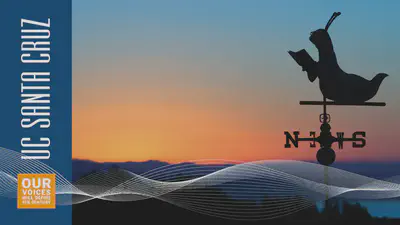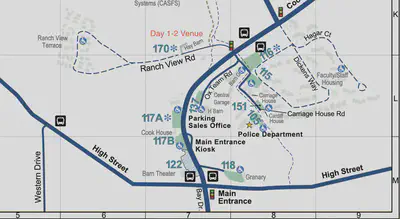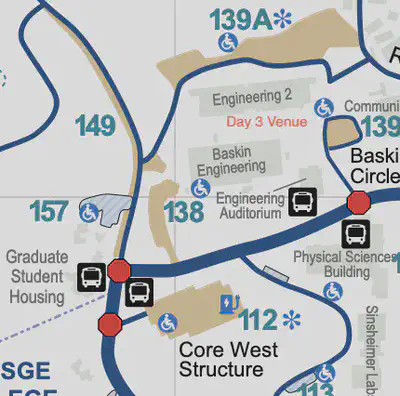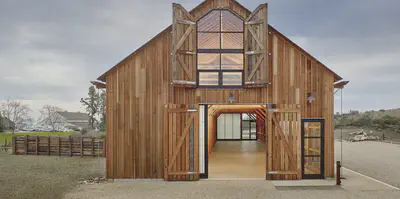Directions: Getting There

Getting Around

Carpooling
We strongly urge those of you who are driving to consider carpooling with other attendees. Traffic, even in summer, can be heavy on campus and it might be easier and simpler to carpool wherever possible.
With that in mind we have set up a Google sheet where you can sign up to offer a ride or request a ride.
If you are looking for riders, enter your information for each day in the green “Looking for Riders” sections on the list. If you are looking for a driver, then enter your information for each day in the blue “Looking for Drivers” sections on the list.
Uber & Lyft
Using Uber or Lyft is another way to get to campus without having to find parking.
Santa Cruz Metro Transit
The local public transportation system is also a fine way to get around and has regularly scheduled buses with multiple stops on UC Santa Cruz campus, including “UCSC - Main Gate” which is a short walk to the Hay Barn where the conference takes place on Days 1 and 2, and “Science Hill (UCSC)” which is a short walk to Engineering 2 where the tutorials and workshops on Day 3 are located. It costs $2 cash (need to have exact amount) for one ride. You can also order and buy passes online (Fares, Map, Schedule).
UCSC Shuttles
In addition to the Santa Cruz Metro buses, UCSC runs campus shuttle buses. The shuttles (aka “UCSC Loop Bus”) are free and useful for getting around within campus (Map and Schedule). For Days 1 and 2 the bus stop closest to the Hay Barn is “Lower Campus”. On Day 3 the bus stop closest to the tutorials and workshops is “Science Hill”, the one closest to Physical Sciences and Jack Baskin Engineering buildings near the upper left of the map. Buses operate in both directions and both directions are about the same distance between the campus main entrance and the Science Hill (for buses going the clockwise direction, use the “Barn Theater” bus stop across the street from the “Main Entrance” bus stop).
Conference Parking
Parking permits are required for parking near the conference venue. On Tuesday, June 27, 2023 (Day 1), 8:30-10:30am TAPS attendants will be available on parking lot 116 (map coordinates L-8, see campus parking map) to sell 1-, 2-, and 3-day parking permits for $10/day.

After Day 1, 10:30am, daily parking permits can to be purchased at the Main Entrance Kiosk (M-7) or the TAPS Sales Office (L-7). Lot 116 also has a few parking spaces that can be paid for via the ParkMobile app (also useful for parking in downtown Santa Cruz). For Day 3, Google Maps driving directions are available for “UCSC Core West Structure” (Lot 112, map coordinates C-4).

Venue: Cowell Hay Barn

The original Cowell Ranch Hay Barn was built in the early 1860s as part of the Cowell Lime Works operation. The Hay Barn was an integral part of the Cowell Ranch, housing feed and the animals that hauled logs, limestone, and finished lime. Today the Hay Barn and the many nearby historic structures from the lime works period are part of the Cowell Lime Works Historic District.
The original Hay Barn was completely disassembled and renovated in 2015 to serve as a space for public use and headquarters of the Center for Agroecology & Sustainable Food Systems.
The reconstructed Hay Barn incorporates some of the historic barn’s heavy timbers and siding, and features traditional mortise-and-tenon framing juxtaposed with modern materials and contemporary design, to achieve a rustic yet visually distinct building. The award-winning result is a beautiful and dramatic signature building with a soaring, spacious interior offering a unique setting for weddings, banquets, concerts, conferences, and much more. See https://cowellhaybarn.ucsc.edu/ for more information about the Hay Barn and its history.
UC Santa Cruz

A campus with world-class facilities and one of the most visually spectacular settings in higher education, UC Santa Cruz offers rigorous academic programs and cutting-edge research opportunities that teach students how to think, not what to think. Commitments to environmental stewardship and community engagement are central to UCSC’s core values.
From 652 students in 1965, the campus has grown to its current enrollment of around 19,000 students (2021-2022). Undergraduates pursue bachelor’s degrees in 65 different majors supervised by divisional deans of arts, engineering, humanities, physical & biological sciences, and social sciences.
Graduate students work toward graduate certificates, master’s degrees, or doctoral degrees in 65 academic programs under the supervision of the divisional and graduate deans.
The 10 UC Santa Cruz undergraduate colleges — each a separate community with its own buildings and administration — are built around a core of shared university facilities. These include the main and science/engineering libraries, performing arts buildings, visual arts studios, classrooms, computer facilities, and a complex of highly specialized buildings for the physical and biological sciences, and for engineering. Athletic facilities are provided on the east and west sides of the campus.
UC Santa Cruz is increasing both its enrollment and resources and diversifying its educational and research opportunities. New academic programs are considered and added when desirable and feasible. The campus’s physical growth is guided by its most recent Long-Range Development Plan. In 2013-14 the campus initiated a strategic planning process to identify priorities and published its final report in March 2017.
A number of state-of-the-art buildings have been completed on campus in recent years, including the Biomedical Sciences Building, the Humanities and Social Sciences Facility, the Digital Arts Research Center, and the McHenry Library expansion. A restored and updated Quarry Amphitheater reopened in fall 2017.
UC Santa Cruz continues to move forward with its Silicon Valley Campus, a multi-disciplinary teaching and research hub that is home to a master’s degree program in games and playable media, engineering faculty, the new office of industry alliances and technology commercialization, UCSC Silicon Valley Extension, and UC Scout.
Go to https://www.ucsc.edu/visit/index.html to find out more about visiting UC Santa Cruz.